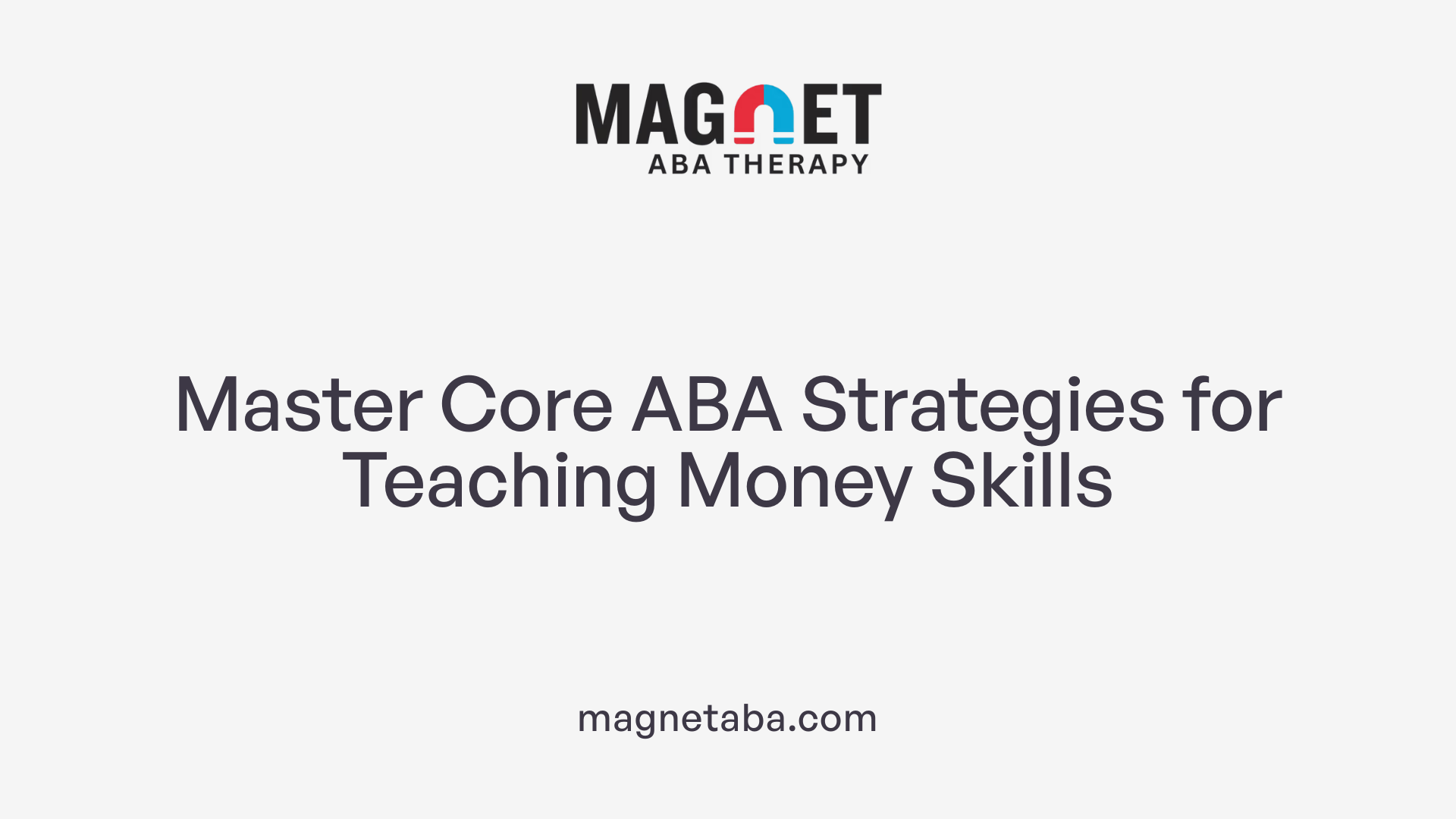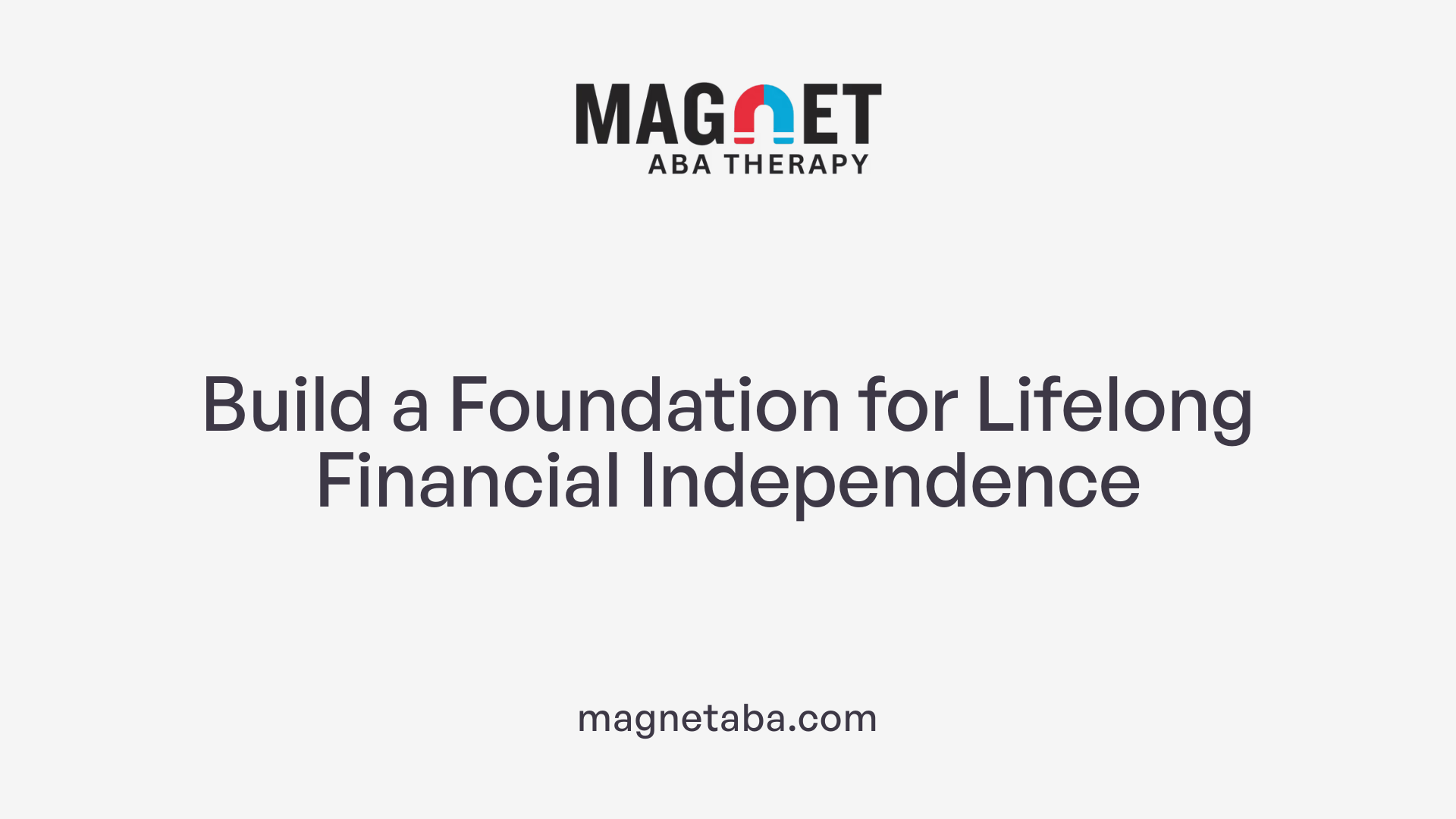Empowering Learners with Autism to Master Money Skills
Teaching money management skills to individuals with autism is a vital step toward fostering independence and societal participation. Approached through the lens of Applied Behavior Analysis (ABA), these strategies incorporate concrete, structured methods that address common challenges such as abstract thinking difficulties, sensory sensitivities, and social understanding issues. This article explores effective ABA techniques for teaching financial literacy, highlighting practical strategies, educational resources, and the crucial role of community-based practice.
Foundational ABA Teaching Strategies for Money Skills

What are the main ABA teaching strategies?
Applied Behavior Analysis (ABA) offers several effective strategies to teach money management skills, especially for individuals with autism. These approaches are designed to make complex skills more manageable and promote lasting learning through reinforcement and structured practice.
The primary ABA methods include:
| Strategy | Description | Application in Money Skills |
|---|---|---|
| Discrete Trial Teaching (DTT) | Breaks down skills into small, discrete steps with clear prompts and reinforcement | Teaching coin recognition, counting bills, or matching prices through structured trials |
| Naturalistic Teaching | Uses everyday routines and natural environments to teach skills | Practicing money skills during shopping activities or classroom stores |
| Pivotal Response Treatment | Focuses on motivation and responsiveness to natural cues | Engaging learners in money-related tasks that interest them, like selecting items in a shop |
| Token Economy | Uses tokens or points as reinforcement that can be exchanged for rewards | Rewarding successful transactions or accurate coin identification |
| Contingent Observation | Learners observe model behaviors that are reinforced | Watching peers or teachers correctly make change or count money |
These strategies rely on fundamental techniques like shaping, prompting, and chaining—methods that gradually build complex skills from simple behaviors. They encourage children to learn each part of managing money before combining them into full transactions.
How do these strategies promote learning?
By systematically applying reinforcement, whether through praise, tangible tokens, or access to preferred activities, learners are motivated to practice and refine their skills. For example, in teaching coin recognition, a teacher might initially prompt the learner to identify a penny, then gradually reduce prompts as they recognize the coin independently.
Video modeling, including video self-modeling, serves as a powerful tool for demonstrating challenging behaviors like giving correct change or making purchases. This visual support helps learners understand sequences and develop independence.
In natural settings like simulated shopping or controlled community trips, these skills can be generalized and stabilized in real-life contexts. This approach aligns with ABA principles by creating meaningful, functional learning experiences tailored to each individual's needs.
Example of a structured teaching sequence:
- Recognize and name different coins and bills.
- Match coins to their corresponding values.
- Practice counting coins using step-by-step tasks.
- Role-play shopping scenarios using real or pretend money.
- Practice making change and understanding transaction amounts.
Tools and activities supporting money skills learning
| Tool/Activity | Description | Benefit |
|---|---|---|
| Number lines | Help assess relative amounts and understanding of value | Visual aid for comparison |
| File folders and task cards | Practice matching coins to prices | Differentiated learning |
| Simulated shopping | Real-life application of skills | Contextual understanding |
| Use of real coins/bills | Concrete learning experience | Enhances generalization |
| Educational apps | Interactive learning tools | Engagement and immediate feedback |
Promoting independence in the long-term
As individuals progress, teaching encompasses budgeting, saving, and paying bills—skills essential for independence. Using a step-by-step, ABA-based approach ensures learners acquire these skills gradually. For example, teaching the 'Next Dollar Up' strategy helps learners understand how to give more than the purchase amount, which is vital for successful transactions.
By incorporating structured routines, visual supports, and real-world practice, educators and caregivers can build a robust foundation for financial independence. Continuous reinforcement and opportunities for generalization across settings are crucial for maintaining these skills over time.
| Summary of Teaching Methods | Focus Area | Application |
|---|---|---|
| Discrete Trial Teaching | Stepwise skill acquisition | Coin identification, counting |
| Naturalistic Teaching | Real-world relevance | Shopping, community trips |
| Visual Supports & Props | Clarify abstract concepts | Charts, pictorials, real objects |
| Task Analysis & Chaining | Build complex skills | Making transactions, budgeting |
| Technology & Apps | Enhance practice | Budgeting tools, educational games |
This comprehensive approach ensures that teaching money management is effective, engaging, and applicable to daily life, empowering individuals with autism to achieve greater financial independence.
Implementing ABA to Teach Money Skills Effectively
How can ABA be used to teach money skills to individuals with autism?
Applied Behavior Analysis (ABA) offers a highly effective framework for teaching financial literacy to individuals with autism. Central to this approach is the use of concrete, hands-on activities that resonate with learners and facilitate understanding. For instance, role-playing scenarios and simulated shopping activities allow learners to practice real-life transactions in a controlled environment.
Using real or pretend money—such as coins and bills—helps learners grasp the concept of monetary units and their values. Visual supports, including charts, task cards, and pictorial aids, serve as useful tools to illustrate how money works, helping students recognize, match, and understand the relative worth of different coins and notes.
A structured method involving task analysis breaks down complex skills, such as making change or counting money, into manageable steps. This step-by-step approach ensures mastery of each component before moving on to more advanced skills.
Community-based instruction extends these learned skills outside the classroom, offering practical experiences like shopping trips, thereby promoting generalization. Skills such as requesting assistance, giving change, and budgeting are incorporated into everyday activities, reinforcing functional independence.
Advanced methods, such as stimulus equivalence procedures, help establish associations among different monetary stimuli, making it easier for learners to understand the value of coins and notes without explicit teaching of every concept.
Overall, ABA techniques—by combining reinforcement, visual supports, task analysis, and real-life practice—create a comprehensive approach to teaching money management skills to individuals with autism, ultimately helping them achieve greater independence and participation in society.
Teaching Complex Money Skills Using ABA Methods
What methods are used in ABA to teach complex skills such as money management?
In the realm of Applied Behavior Analysis (ABA), effective strategies such as prompting and fading are pivotal for teaching multifaceted skills like money management. These methods involve breaking down complex tasks into manageable parts and systematically reducing the level of assistance provided as the learner improves.
One common prompting technique is most-to-least (MTL) prompting, which starts with the most intrusive prompts—such as full physical guidance—and gradually diminishes assistance. This approach helps learners reduce errors and retain skills efficiently. Conversely, no-no-prompt (NNP) involves giving clear instructions first, then repeating them before prompting, encouraging learners to respond independently.
Research indicates that NNP often leads to quicker initial acquisition of skills. However, MTL prompting tends to result in fewer mistakes and better long-term retention of money management skills. Combining these strategies and tailoring them to individual learner needs—such as their level of understanding, sensory sensitivities, or executive functioning deficits—can significantly enhance learning outcomes.
The methodology also emphasizes reinforcing learned behaviors through consistent feedback and gradually increasing the complexity of tasks. For example, starting with recognizing coins and bills, then moving on to making transactions, budgeting, and understanding the value of money. This structured approach aligns well with ABA principles and supports the development of independence in financial skills.
How do visual aids and apps support teaching money skills?
Visual supports are essential tools in teaching financial literacy to individuals with autism. Charts, pictorial representations of coins and bills, and task cards help learners visualize the concept and facilitate better comprehension. For example, matching coins to their values or using number lines to compare amounts can bridge abstract ideas about money.
Technology further enhances these visual supports. Budgeting and money management apps tuned to learners' levels can provide interactive opportunities for practice. These tools allow learners to simulate real-life scenarios such as shopping, making change, or paying bills in a controlled environment. The use of apps can also individualize learning, allowing instruction to adapt to the pace and needs of each person.
How are sequential and chained teaching methods incorporated?
Sequential teaching involves breaking down money skills into small, teachable steps, which are then reinforced through chaining—connecting each component in a logical order. For instance, the first step might be recognizing coins, followed by matching coins to their values, then counting coins, and finally completing transactions.
Chaining techniques, including forward chaining (teaching the first step first and then moving forward) or backward chaining (starting from the final step), help in creating a natural flow of skills. Using file folders, task cards, or simulated shopping activities, educators can provide structured practice. This structured approach ensures that each component is mastered before progressing, building confidence and competence.
How does reinforcement and feedback foster skill acquisition?
Consistent reinforcement and constructive feedback are cornerstones of ABA-based teaching. Reinforcement involves providing immediate praise, tokens, or access to preferred items when the learner successfully performs a step. Feedback helps clarify mistakes and guides learners toward correct responses.
Implementing a reward system tailored to each student heightens motivation, making learning engaging and rewarding. For example, earning classroom money for successful role-plays or practice sessions can promote enthusiasm.
How can skills be generalized in real-world settings?
To promote generalization, teaching must extend beyond the classroom into community environments and daily routines. Activities like shopping trips, cooking, or managing a community store mimic real-life situations.
Role-playing exercises, mock stores, and community outings allow learners to apply skills naturally. For example, practicing making purchases with actual coins or using digital payment tools helps solidify understanding.
Customizing the environment to include real objects like groceries or real money ensures that learners transfer skills effectively. Reinforcing skills in multiple contexts supports independence and confidence in everyday money management.
Incorporating Play and Social Skills in Money Management Education

How can play skills be incorporated into ABA therapy for children with autism?
Play is a vital element in ABA therapy, especially when teaching skills like money management to children with autism. Effectively integrating play involves customizing activities to match each child's interests and developmental level. Therapists typically follow a structured three-step approach: Join, Imitate, and Expand. This means they first engage with the child's current play, imitate their actions to build rapport, and then gradually introduce new ideas or objects to extend the activity.
This process helps promote engagement, flexibility, and learning. For example, a therapist might join a child's pretend store scenario, imitate the child's role-playing, and then introduce coins or bills as part of the game. Incorporating sensory routines, pretend play, and scenario-based tasks supports the development of social, communication, and cognitive skills.
Reinforcing social routines such as sharing, turn-taking, and greetings during play fosters cooperative behaviors essential for real-world money interactions. Moreover, integrating language development through visual supports, props, and scripts during play enhances communication skills and generalizes learning.
Engaging Play Activities for Money Skills
Using play-based activities makes money management skills tangible and meaningful. Some of these include:
- Role-playing shopping: Using mock stores and real or toy items to practice budgeting, making change, and purchasing.
- Coin recognition games: Such as matching coins with their names and values, or sorting coins for different transactions.
- Simulation activities: Setting up grocery store scenarios where children practice paying with coins or bills.
- Using props and visual supports: Including pretend money, shopping lists, and price tags to guide learning.
- Scenario-based games: Like earning profits from classroom jobs and managing their earnings.
These activities can be adapted to match each child's skill level and specific learning goals.
Social Routines and Cooperative Play
Money management also benefits from social routines embedded in play. Practicing turn-taking during shopping games, sharing coins, and cooperating in group tasks help children develop social interaction skills aligned with financial concepts.
Structured routines, like greeting shopkeepers, asking for items, and saying thank you, mirror real-life social interactions involved in transactions. These routines can be practiced during role-play or community outings.
Language Development During Play
Language skills are reinforced as children describe their actions, ask questions, and follow directions during play activities. Visual aids such as picture cards, scripts, and props facilitate understanding.
Encouraging children to verbalize their choices and describe their reasoning promotes expressive language. For example, they might say, "I need three coins to buy juice" or ask, "Can I have more change?"
Scenario-Based and Pretend Play
Pretend play scenarios, like running a store or bank, mimic real-life money handling tasks. These role-plays allow children to practice concepts like saving, budgeting, and counting change in a safe environment.
Scenario-based activities promote problem-solving, decision-making, and social interaction. Reinforcing these skills through engaging play helps children generalize learned money skills to everyday situations.
| Aspect | Activity | Purpose | Tools/Supports |
|---|---|---|---|
| Recognition | Coin matching games | Learn coin types and values | Toy coins, picture cards |
| Social | Role-playing shopping | Practice transactions | Store setups, cashier scripts |
| Language | Describing actions | Enhance communication | Visual supports, prompts |
| Cognitive | Budgeting games | Develop planning skills | Play money, coins, bills |
| Cooperation | Group shopping activities | Foster social routines | Shared tasks, turn-taking cues |
By integrating play into money management teaching, educators and therapists can create engaging, functional learning experiences. This approach not only builds financial skills but also promotes social interaction, language development, and overall independence.
Supporting Long-term Independence and Financial Competence

Skills Development Over Life Stages
Teaching financial skills to individuals with autism is a gradual process that evolves through different stages of life. Early intervention focuses on recognizing coins and bills, understanding their basic value, and engaging in simple exchanges. For children, methods such as matching coins to their corresponding values and using visual aids like charts or pictorial representations lay a strong foundation.
As they grow, the focus shifts to developing more complex skills such as budgeting, saving, and understanding the concept of making change. Educational activities incorporate real objects, such as grocery items, and simulated shopping scenarios to foster generalization of money skills. Classroom setups with mock stores or real-world trips enable practical application.
For adolescents and young adults, skills expand to managing personal finances, including paying bills, planning budgets, and making informed purchasing decisions. These stages require structured practice, progressively increasing independence with financial tasks.
Budgeting, Saving, Paying Bills
Core money management skills include understanding the importance of budgeting, saving, and paying bills. Visual supports, such as charts and number lines, are instrumental in helping learners grasp the relative value of money and assess purchasing power.
Using tools like templates or jigs simplifies the process of calculating costs and making exchanges. For example, the ‘Next Dollar Up’ strategy teaches individuals to give a bit more than the purchase amount, reinforcing their understanding of how much money they need.
Practical activities such as earning classroom money through jobs, practicing in mock stores, or community-based shopping trips promote real-life application. These experiences prepare individuals to handle financial responsibilities confidently outside the classroom.
Real-world Practice and Community Involvement
Fostering independence in money skills involves consistent real-world practice. Simulated shopping activities and trips to community stores help generalize skills learned in structured settings. Engaging individuals in budgeting during holiday shopping or trips to the grocery store encourages transfer of skills to daily life.
Additionally, routine participation in community activities, like working or volunteering, offers opportunities for authentic financial exchanges and decision-making.
Family involvement and community resources play a crucial role in reinforcing financial skills and promoting independence. Teaching individuals to recognize their buying power and make sound financial choices supports their long-term autonomy.
Tools and Resources for Financial Literacy
Using specialized tools enhances engagement and learning efficiency. Visual supports such as charts, pictorial representations, and task cards help learners with limited counting skills or abstract thinking.
Digital applications, including budgeting and financial literacy apps designed for autism, are effective in reinforcing concepts like saving and spending. These tools often incorporate gamification and interactive elements that sustain motivation.
Moreover, ABA-based strategies emphasizing step-by-step instructions, stimulus class formation, and matching techniques facilitate skill acquisition with minimal explicit training. Methods like touching coins to identify their value or using 'touch money' technology help individuals learn to determine coin and bill worth.
Educational resources also include templates for matching coins, number lines for relative amounts, and real object use during practice. These facilitate differentiated instruction tailored to individual needs.
Summary Table of Money Skills Teaching Strategies
| Strategy | Description | Best For |
|---|---|---|
| Concrete concepts | Starting with real coins and bills | Beginners, early learners |
| Visual supports | Charts, diagrams, pictorial aids | Understanding and retention |
| Breaking tasks into steps | Small, manageable goals | Building complex skills |
| Technology-based tools | Apps, digital games | Engagement and practice |
| Real-world practice | Shopping, community trips | Generalization and independence |
| Role-playing scenarios | Simulated transactions | Applying learned skills in safe environment |
| Use of physical props | Templates, jigs | Supporting students with limited counting skills |
| Structured routines | Consistent practice sessions | Skill retention and confidence |
Effective ABA Strategies for Teaching Financial Literacy
ABA interventions tailored for autism emphasize systematic learning through small steps and visual supports. Modeling, reinforcement, and practical scenarios are central components.
By continuously modeling how to recognize coins, understand their value, and perform basic transactions, educators can reinforce learning. Reinforcers like praise or preferred items motivate correct responses and increase independence.
Hands-on activities, such as mock shopping or using real money in controlled settings, help reinforce skills and build confidence. Incorporating community trips and real-life practice helps generalize learning beyond the classroom.
Specialized resources like visual budgeting apps and autism-friendly banking options are also valuable. These tools foster independence and promote understanding in a familiar, engaging manner.
Ultimately, combining structured ABA methods with community involvement and technology creates a comprehensive approach. This empowers individuals with autism to develop essential money management skills, paving the way for greater financial independence in adulthood.
Promoting Independence Through ABA Money Skills Education
Teaching money skills through ABA approaches not only equips individuals with autism with essential life skills but also fosters greater independence and societal participation. By utilizing concrete, systematic methods such as task analysis, visual supports, role-playing, and community-based practice, educators and caregivers can effectively address the unique challenges faced by learners. Incorporating technological tools and real-world experiences ensures skills are generalized and maintained over time. As research continues to support these methods, the strategic use of ABA for financial literacy promises improved outcomes and greater self-confidence for individuals on the autism spectrum.
References
- Helping Individuals with Autism Learn Money Management Skills
- Teaching money skills through stimulus class formation, exclusion ...
- How to Make Teaching Money Engaging and Functional
- Money Skills - Life Skills Resource - Middletown Centre for Autism
- ABA Teaching Strategies
- ABA Techniques: Strategies for Behavior Analysts - GSEP Blog
- How to Use ABA in the Classroom
- Effective ABA Strategies for Students with Autism - TeachTown Inc.











